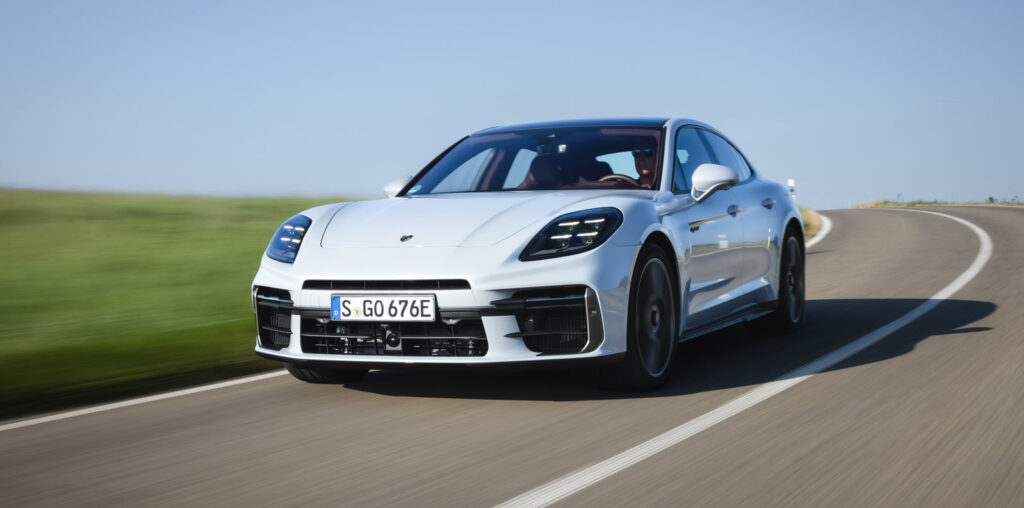Finally, the Turbo E-Hybrid (which is badged simply ‘Turbo’) uses the same electric components but with a twin-turbocharged 4.0-litre V8. This engine has been significantly upgraded compared with the outgoing version, mainly so it can continue to comply with emissions demands. It swaps its twin-scroll turbos for single-scroll items, because the latter are physically smaller lumps of metal and thus warm up faster. In turn, they draw less heat from the exhaust system and allow the catalysts to warm up quicker – a requirement for Euro 7. Additional turbo lag is rendered moot by the hybrid system’s torque fill.
Then there’s the top-of-the-line Turbo S E-Hybrid. This model is ostensibly a Panamera Turbo E-Hybrid with an angrier V8 and all of the right options boxes ticked. It runs precisely the same 188bhp hybrid drive system as the lesser Turbo, but the 4.0-litre turbo V8 is turned up to produce 592bhp and 590lb ft, making for a 772bhp total system power output that’s mighty enough to eclipse a certain new BMW M5. Just as Munich’s own hybrid ’bahnstormer starts rolling out of showrooms; what a remarkable coincidence.
As with the lesser E-Hybrid models, the Turbo S’s biggish drive battery enables a company car tax-friendly electric-only range (47 to 59 miles, depending on the version), and thanks to advances in technology, it doesn’t take up any more space or weigh significantly more than the old unit.
Still, even the most basic rear-driven Panamera is quite a heavy car, at about 1.9 tonnes – and to manage that and make sure the Panamera drives like a Porsche, every version now features air suspension as standard.
The standard air suspension set-up now includes adaptive dampers with separate valves for the bump and rebound, so they can be independently adjusted. These more sophisticated dampers have allowed Porsche to change from three-chamber air springs to lighter, simpler two-chamber items.
For Panamera buyers who want sporting appeal without the electrification, there is the GTS model. This version’s suspension and powertrain hardware get unique sporting twists, as does its standard cabin spec, in the way that previous GTS models have made familiar. The adaptively damped, height-adjustable air suspension runs with 10mm-lower ride height than a lesser Panamera has, and with special tuning (passive anti-roll bars twice as stiff as the standard car’s, and special damper and power steering calibrations). You get a torque-vectoring active rear differential for the rear half of the standard four-wheel drive system as standard too, as well as a specially tuned active sports exhaust. Carbon-ceramic brakes and active four-wheel steering remain options.
Externally, GTS models are distinguished by their SportDesign bodykits and black body trim and badging, as well as by Porsche’s signature 21in centre-lock forged alloy wheels.
The truly exciting advances are reserved for the hybrids, however, since the 400V system can be employed to do more than just drive the car. On the optional Porsche Active Ride (PAR) system, it powers four hydraulic pumps – one for each corner. These in turn provide the pressure for hydraulic actuators in the air suspension that can stiffen, soften, lift or lower each corner of the car independently, thus enabling all manner of magic tricks. The air springs themselves go down to one big chamber to make them very soft – most of the stiffness can come from the actuators. PAR also does away with anti-roll bars.
The system draws its data from the steering, accelerator, brakes, accelerometers and, most importantly, sensors in the suspension itself. It doesn’t use cameras to monitor the surface, because they’re unreliable when obscured. Given the suspension can adjust 13 times per second, it doesn’t need to be proactive anyway.
At the car’s press launch in Spain in early 2024, Porsche had a static demonstrator that could dance on its suspension like one of those American low-riders. More usefully, PAR can cancel out nearly all body roll, or even overcompensate and lean the car into corners, and counteract pitching under acceleration and braking. And on rough roads it can lift up the wheel for bumps and push it down into potholes.

